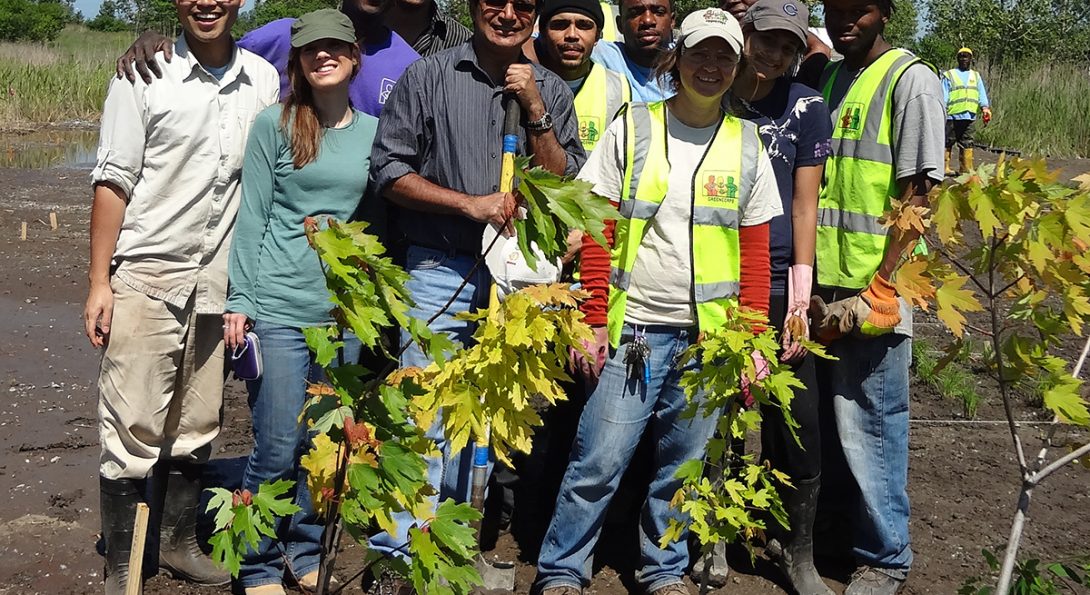Professor Reddy’s ‘green’ research named best of 2018

story title Heading link
A journal paper co-authored by CME Professor Krishna Reddy was named the best of 2018. The paper, “Field-Scale Phytoremediation of Mixed Contaminants in Upland Area of Big Marsh Site, Chicago, USA,” published in Indian Geotechnical Journal, was deemed the best paper published in the journal and awarded the IGS- AIMIL Biennial Award.
The paper documents a collaboration between Reddy, his student Gema Amaya-Santos, and Chicago Park District Environmental Engineer Daniel E. Cooper, and their findings as they worked to fix a contamination problem at the Big Marsh. The Big Marsh is a park on the Chicago’s South Side in the Lake Calumet area, which is approximately 280 acres of marshland and vegetation, and almost as big as Grant Park.
“The area was used for dumping in the past,” said Reddy. “Steel plants used to dump steel slag, which is a waste product. There was illegal dumping – fly dumping – so there was all kinds of stuff going on there. They found that there are some elevated concentrations of metal and organic contaminates with concentrations above risk levels.”
Reddy’s expertise is in environmental remediation of soils and ground waters, and he has worked on many different technologies in this field. However, as he started evaluating what technologies could be used he continued to run into multiple obstacles.
“The challenge is that it’s an enormous site and the soil can’t be removed and treated elsewhere,” he said. “We came up with phytoremediation as the best option. Phytoremediation is basically growing plants, and, through different mechanisms, the contamination gets removed from the soil. It transforms the contamination into some other non-toxic form, or it could stabilize the contamination in the soil so it can’t spread out.”
Another problem the team faced was the combination of metals and organic contamination at the site, which have different chemistry structures. Some studies showed only metal removal, and other studies showed only organic contamination removal, but they hadn’t come across anything that showed a mixture.
“We did research in our lab to find out which plants can actually survive at the concentration levels measured, and achieve the remediation of the contamination,” said Reddy. “We found out some plants are good. However, when we wanted to use them in the field, we realized we can’t use any plants that we find good, because they have to fit in with the environment. It’s a restoration project, and we had to work with native species.”
The team selected approximately 17 plant species to test, which included grasses, shrubs and trees. Again, the site size played a factor as they observed different soil conditions at different locations. So they selected three areas, which were representative of the different soil conditions.
“We did soil samples, planted the plants, and monitored the plants,” said Reddy. “To our surprise, many plants died. That was one of the interesting conclusions. Those that didn’t die, we continued to monitor. At the end of the first year, we took samples of the soil and the plants – roots, stem and leaves – to analyze in the lab and examine the changes.”
The team continued the research for three years and discovered that the plants reduced the concentrations of the organics in the soil. While the metals were not removed completely, they were found to be strongly held compared to the initial testing when it was easily leachable. After the planting the metal leaching was low.
“It was an interesting project to see a green way to clean up the site,” said Reddy. “Now, there are bike trails and the city plans to convert the space into a huge open space with hiking trails. This will have a lot of benefits for residents to enjoy the site.”
“I enjoyed the project and the students loved it. We do a lot of research in the lab, but this allowed us to go out into the field,” he added. “I’d like to work on more of these projects in the future. I want to get involved in [city] projects since there are a lot of things going on. They are looking into solving the problems and we can help them out with our research in green and sustainable remediation solutions.”
While the research was conducted in Chicago, it grew in popularity when it was published in the Indian Geotechnical Journal.
“The project is quite interesting,” said Reddy. “A lot of people took to the idea and want to do something in India because there is a lot of pollution.”
Reddy is the director of the Sustainable Engineering Research Laboratory and the Geotechnical & Geoenvironmental Engineering Laboratory at UIC. Learn more about his research at https://gagel.lab.uic.edu.